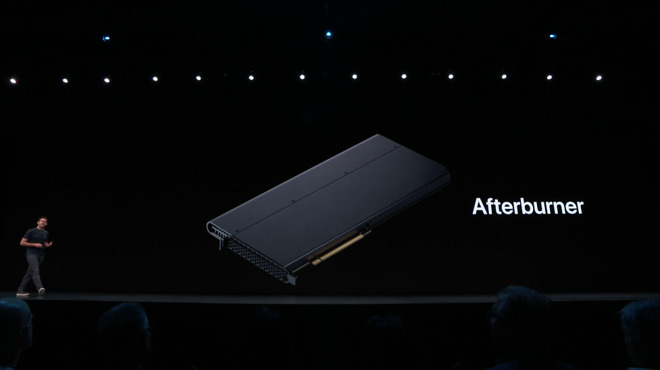Afterburner card is a $2,000 add-on for the Mac Pro, and wheels are $400
The Afterburner card, an optional add-on for the Mac Pro that helps improve the video-editing experience, is priced at $2,000 when ordered preinstalled in the new modular Mac workstation. And, then, there's the $400 wheels.

Found in the just-launched ordering process for the new Mac Pro, the section to add an Apple Afterburner card gives customers the option to add the card to their configuration. Selecting to include the Afterburner in the Mac Pro is a $2,000 add-on, making it an expensive addition with a relatively limited feature set.
An Apple Store page reveals it will be available to purchase separately, at the same $2,000 cost.
0
The Afterburner card was revealed at the launch of the new Mac Pro as a way to make the workstation even better for video editing. Technically a Field Programmable Gate Array (FPGA) or a programmable Application-Specific Integrated Circuit (ASIC), the card is made to run one task at a very high performance, in this case by effectively performing a transcoding process.

The Afterburner revealed on-stage at WWDC 2019's keynote
Apple's Afterburner includes over a million logic cells, allowing it process up to 6.3 billion pixels per second. It is designed to handle the encoding and decoding of ProRes and ProRes RAW codecs for Final Cut Pro X and QuickTime Player X, along with some third-party applications, and are typically used only in video production.
According to the ordering page, the Afterburner will be preinstalled in PCI Express slot 5 (x16) "to enable maximum performance."
The limited abilities of the card means it also has a fairly small audience involved in video production, making it a tough buy for industries that don't use video. However there is also the possibility Apple could offer to make changes to the card to allow it to be used for other specific tasks in the future, as it already has the opportunity to improve the card's performance for video tasks via firmware updates.

Found in the just-launched ordering process for the new Mac Pro, the section to add an Apple Afterburner card gives customers the option to add the card to their configuration. Selecting to include the Afterburner in the Mac Pro is a $2,000 add-on, making it an expensive addition with a relatively limited feature set.
An Apple Store page reveals it will be available to purchase separately, at the same $2,000 cost.
0
The Afterburner card was revealed at the launch of the new Mac Pro as a way to make the workstation even better for video editing. Technically a Field Programmable Gate Array (FPGA) or a programmable Application-Specific Integrated Circuit (ASIC), the card is made to run one task at a very high performance, in this case by effectively performing a transcoding process.

The Afterburner revealed on-stage at WWDC 2019's keynote
Apple's Afterburner includes over a million logic cells, allowing it process up to 6.3 billion pixels per second. It is designed to handle the encoding and decoding of ProRes and ProRes RAW codecs for Final Cut Pro X and QuickTime Player X, along with some third-party applications, and are typically used only in video production.
According to the ordering page, the Afterburner will be preinstalled in PCI Express slot 5 (x16) "to enable maximum performance."
The limited abilities of the card means it also has a fairly small audience involved in video production, making it a tough buy for industries that don't use video. However there is also the possibility Apple could offer to make changes to the card to allow it to be used for other specific tasks in the future, as it already has the opportunity to improve the card's performance for video tasks via firmware updates.


Comments
Design a reconfigure and it becomes an image analyser or something designed for massive database searches.
It's both... The FPGA is programmed to be a ProRes ASIC. In theory, the FPGA could be reprogrammed as some other ASIC, for audio, images, other video functions, etc...
You weren’t going to buy one anyway, so is your complaining about pretend parts for your pretend computer a joke?
Did anyone stop to think that these wheels are likely just a little bit more than just cheap casters? I mean they are responsible for supporting a critical piece of equipment, and would be used heavily if chosen as an option. I mean you wouldn’t buy the wheels if you weren’t going to use them... right?